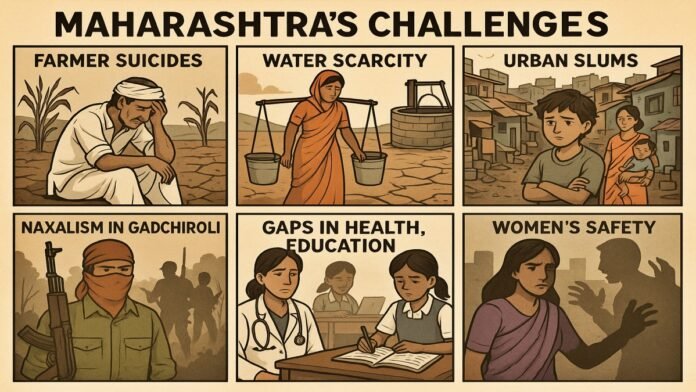
Key Points
- Maharashtra marks its 65th Foundation Day on May 1, 2025, celebrating its formation in 1960.
- The state leads India in industry, finance, and services, with Mumbai as the nation’s economic capital.
- Despite economic progress, Maharashtra faces serious challenges: farmer suicides, water scarcity, urban slums, Naxalism in Gadchiroli, and gaps in health, education, and women’s safety.
- Major redevelopment projects and policy reforms are underway, but political instability and budgetary pressures slow progress.
Mumbai: On May 1, 2025, Maharashtra celebrates its 65th Foundation Day, commemorating the creation of the state from the erstwhile Bombay Presidency in 1960. Known as Maharashtra Din, the day is marked by parades, cultural programs, and a deep sense of regional pride, especially at iconic venues like Mumbai’s Shivaji Park. The state’s journey from an agrarian economy to India’s economic engine is remarkable, yet persistent social and economic challenges remain.
A Journey of Economic Transformation
Maharashtra has evolved from a primarily agrarian state in 1960 to India’s leading economic powerhouse. The state’s GDP has soared, driven by industrialization, the IT boom, robust financial services, and a thriving services sector that now accounts for over 60% of its GDP. Mumbai, the state capital, stands as India’s financial and commercial hub, home to major banks, stock exchanges, and corporate headquarters.
Strategic investments in infrastructure, education, and innovation have positioned Maharashtra as a magnet for talent and investment. The Green Revolution, rapid urbanization, and the rise of alternative sectors like tourism and financial services have further diversified the state’s economy.
Enduring Challenges: The Other Side of Progress
Despite its achievements, Maharashtra’s progress is shadowed by deep-rooted issues that continue to affect millions:
1. Agrarian Crisis and Farmer Suicides
Maharashtra’s farmers, especially in Vidarbha and Marathwada, face chronic distress. In 2024 alone, 2,851 farmers died by suicide, with numbers rising in 2025-a 32% surge in Marathwada in the first quarter of the year. Debt, crop failures, and inadequate support systems drive this crisis, despite repeated loan waivers and relief schemes. Experts and activists blame inconsistent policies and lack of comprehensive action plans for the ongoing tragedy.
2. Water Scarcity in Marathwada
The Marathwada region, encompassing districts like Beed, Latur, and Nanded, is gripped by severe water shortages. In summer 2025, 166 villages required emergency water tankers as reservoirs ran dry. Erratic monsoons, over-extraction of groundwater, and insufficient irrigation infrastructure have made water scarcity a chronic problem, impacting both agriculture and daily life.
3. Urbanization and the Dharavi Challenge
Mumbai’s Dharavi, Asia’s largest slum, epitomizes the urban housing crisis. Over a million people live in cramped, unsanitary conditions, facing challenges like inadequate water supply, poor sanitation, and health risks. The ambitious Dharavi Redevelopment Project, a ₹3 lakh crore initiative, aims to transform the area into a modern township, but logistical, social, and environmental hurdles remain.
4. Naxalism in Gadchiroli
While Naxalism has waned in most of Maharashtra, Gadchiroli district remains affected by Maoist insurgency. Recent years have seen significant surrenders of Maoist cadres and government efforts to spur development, but the region still lags in infrastructure and economic opportunities. The state government is optimistic about eradicating Naxalism, with new roads, mining jobs, and an airport planned for the district.
5. Infrastructure, Health, Education, and Women’s Safety
- Infrastructure: Maharashtra is investing heavily in roads, bridges, and urban projects, planning to raise ₹1.6 lakh crore in 2025-26 for key sectors. However, rapid urbanization strains existing systems, leading to traffic congestion and inadequate housing.
- Healthcare: The public health system is under severe stress, with staff shortages, underfunded hospitals, and a doctor-to-population ratio below WHO standards. Recent hospital tragedies have underscored the need for systemic reform.
- Education: Many government schools lack basic infrastructure, with poor buildings, missing playgrounds, and inadequate water supply. Teacher shortages and irregular student attendance remain persistent issues.
- Women’s Safety: Despite national initiatives like the Nirbhaya Fund and helpline services, crimes against women and gender-based violence continue to be major concerns.
6. Political Instability and Fiscal Pressures
Frequent changes in government and coalition politics have hampered consistent policy implementation. The state’s debt is projected to rise to 18.87% of its gross income in 2025-26, within legal limits but still a challenge for future investment and welfare spending.
Looking Ahead: Opportunities and the Road Forward
Maharashtra’s story is one of resilience and reinvention. By leveraging its strengths in innovation, services, and industry, and by addressing rural distress, water management, urban redevelopment, and social welfare, the state can continue to set benchmarks for the rest of India. Effective governance, sustainable development, and inclusive policies will be crucial for Maharashtra’s next chapter.
As Maharashtra celebrates its 65th year, it stands as a symbol of India’s progress and complexity-a state of immense promise, proud traditions, and persistent challenges. The journey ahead demands not just pride in achievements, but renewed commitment to resolving the issues that still hold back millions of its people.




















































